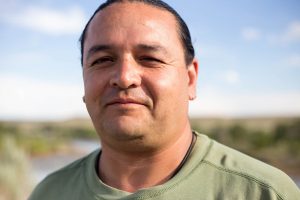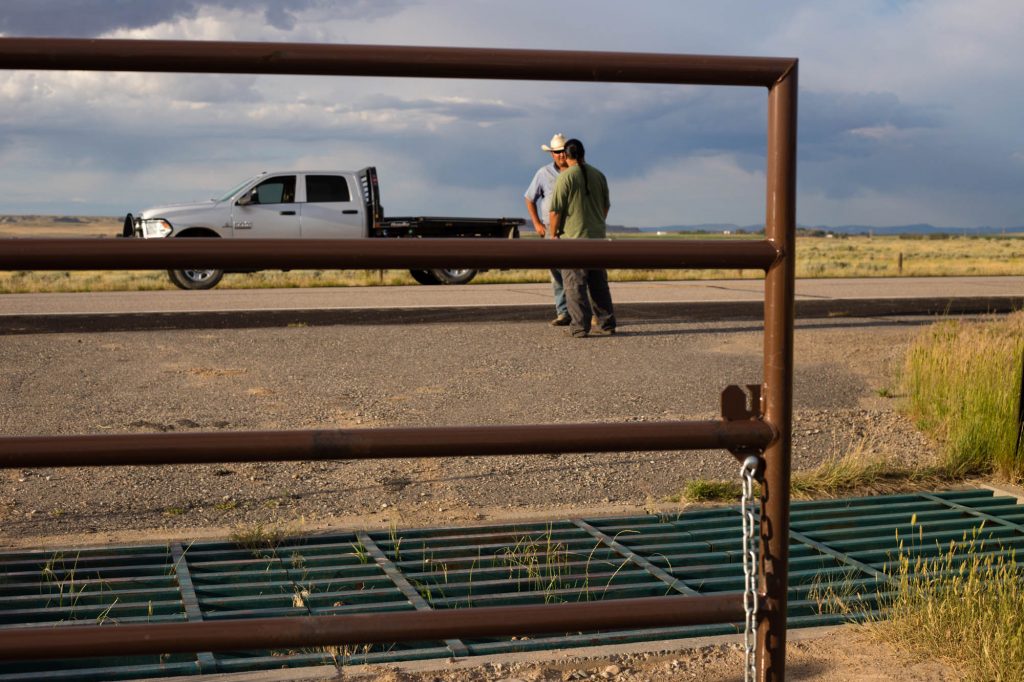Wyoming Wind River tribes want water on their territory to run strong, but they don’t control it

The Wind River diversion dam in Wyoming was built to divert water to mainly non-Native American irrigators on the Wind River reservation. Many Shoshone and Arapaho tribal members fear the complete loss of their fishery because of depleted waters. (Photo by Lauren Kaljur/News21)
FORT WASHAKIE, Wyo. – Jason Baldes stands next to a bridge facing the Wind River diversion dam, a concrete reminder that his Eastern Shoshone tribe does not have the right to use the water on their lands as they want.
Instead, dams and diversions move water toward the many farms in the region, leaving the Wind River depleted to the point that it sometimes runs dry. In what became one of Wyoming’s longest running court battles, known as the Big Horn cases, the state’s Supreme Court ruled that allocating water to benefit fish and wildlife and recharge groundwater was not considered a beneficial use.
“This is an environmental justice issue,” said Baldes, a member of the Shoshone tribe who still takes issue with the court’s decision. “It’s as though the tribes don’t exist when it comes to using water for our purposes.” The Eastern Shoshone tribe’s code lists 15 beneficial uses of water, including fisheries and culture.
In the final 1992 decision, the courts upheld the state of Wyoming’s right to administer Eastern Shoshone and Northern Arapaho water rights, which they had secured in previous court cases, and the tribes’ traditional use of the river as a fishery was barred.
In 1905, farmers were offered land on Native American reservations to encourage agricultural development. The federal government built a massive network of irrigation districts, canals and dams.
“The tribes were hunters and gatherers, fishermen,” said Richard Baldes, who served with the U.S Fish and Wildlife Service for decades and continues to sit on the tribal water board. “If you don’t have enough water in the river, then fishing isn’t any good. And that’s exactly what’s happened as a result of the Bureau of Reclamation building the diversion dam on the Wind River.”
Wind River tribes faced decades long legal battles over water rights from News21 on Vimeo.
Hydrological maps of the region show a stark divide between portions of the reservation dried from the diversions and portions of the reservation fed from the diversions – one side brown, one side green. The green areas are the most concentrated with private land ownership.
Upstream from the dams, fish are healthy. Downstream, there are almost no fish. Sediment deposits are making the area around the dam uninhabitable, and fish are blocked from moving upstream, save for a “largely ineffective” fish ladder designed to help fish get past the dam, according to recent research by Kelli Blomberg out of the University of Wyoming.
Climate change coupled with heavy demands on water for oil and gas industry and agriculture activities are stressing supplies. In an economic study funded by the Wyoming Water Development Commission, Edward Barbier notes that “persistence of drought conditions over much or all of the state of Wyoming in recent years has raised concern as to whether water availability relative to use may be limiting economic growth.” He notes that oil drillers are reportedly striking deals with farmers for use of their irrigation water.

Jason Baldes, A member of the Shoshone Nation in Wyoming, is teaching is sons to hunt and fish. He hopes they will pass on the same to their own children. (Photo by Lauren Kaljur/News21)
At certain times of the year, portions of the Wind River run dry. Past shortages have even caused skirmishes among farmers in the region, according to reports by WyoFile.
“Time and time again, when you look at the history of water for Native Americans, you have to look at the social, political issues that stand in the way of how tribes progress,” said Yufna Soldier Wolf, an Arapaho tribal member.
Paul Robinson is a research director at the Southwest Research and Information Center. “Often Indian water issues are secondary to other water concerns of the states,” he said. “Tribes get water when there is infrastructure for other people getting their needs met.”
He pointed to the management of the Colorado River as an example, where major diversions from northern Arizona and eastern New Mexico to serve urban centers have limited Native Americans’ access to water.
“The trail of tears over Indian water is one where first water users don’t always get control over that right,” he said.
What frustrates Baldes most is that, properly managed, there’s enough water for everyone. His ancestors chose the headwaters of the Missouri River as their home for its wealth of resources, and there should be plenty to go around, he said. He added that the one year that the tribes were able to run instream flow was a drought year, and farmers still had bumper crops.
“We know that the ranchers and farmers need water for their crops. But we also know that fish need water to survive,” he said.
“I believe that the two can co-exist.”

Jason Baldes of Fort Washakie, Wyoming, has many friends who are farmers and has nothing against the industry. He said he wants to see water on the reservation used for both farming and the protection of the fishery. (Photo by Lauren Kaljur/News21)
To see the full News21 report on “Troubled Water,” go to troubledwater.news21.com.